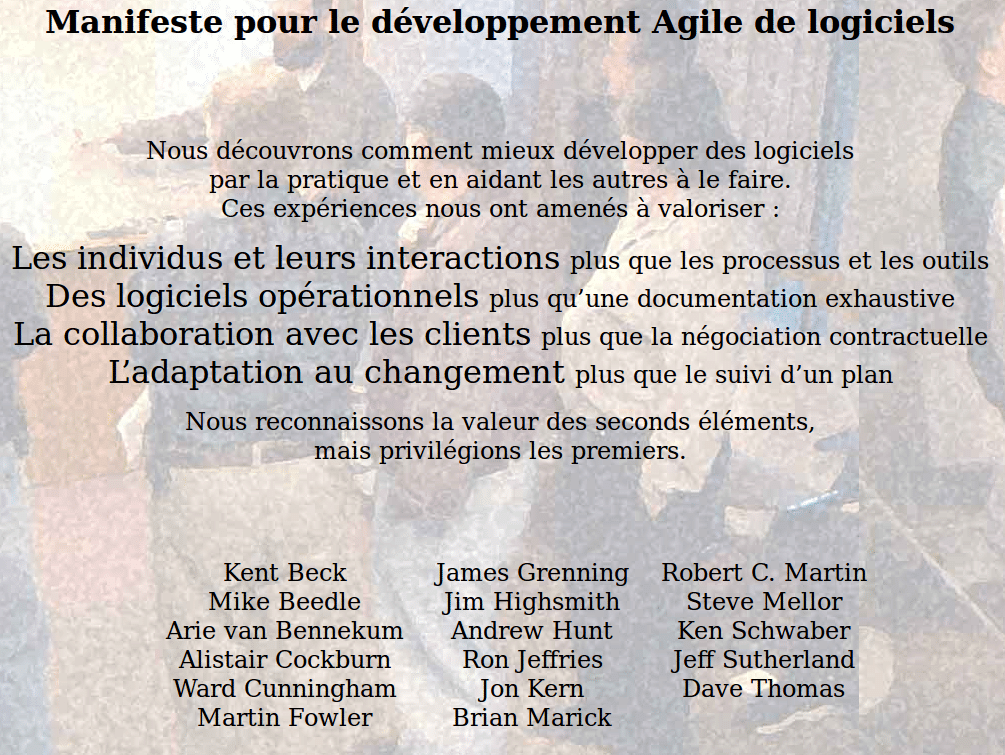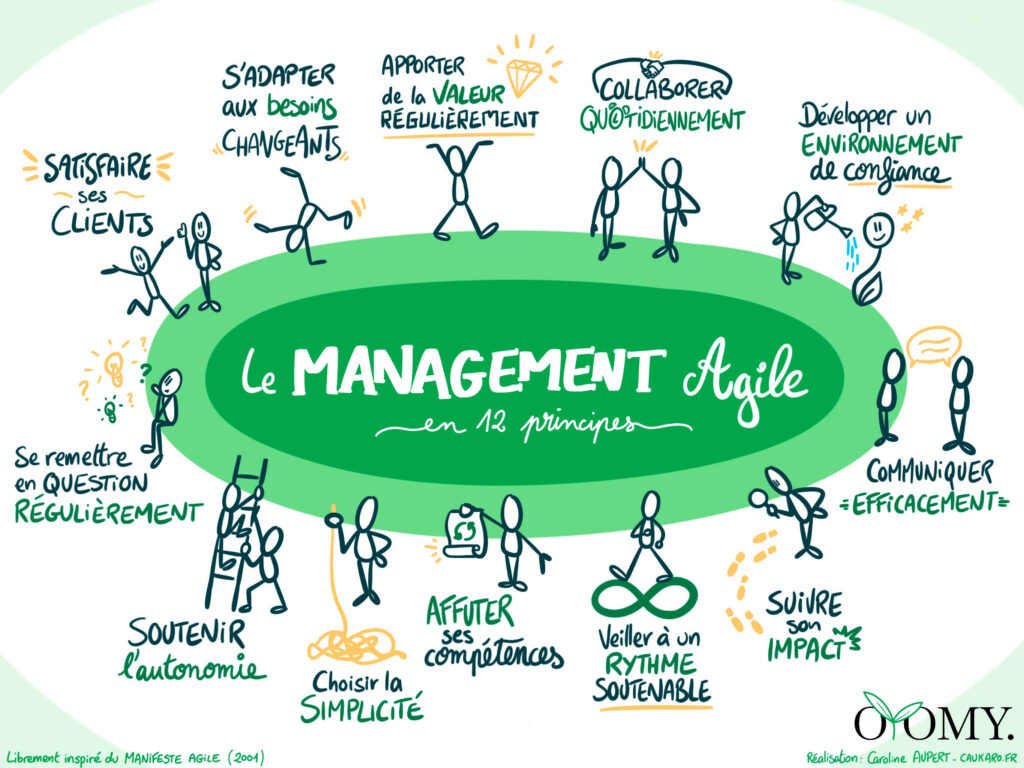
The role of the manager is often mentioned in the context of Agile transformations. Not always in its best light when you see reports like the 16th State of Agile report which describes it as one of the main factors of difficulty for successful Agile adoption in companies.
We then see a movement around “Agile Management” developing for some time. We often find there Management 3.0 practices as well as not so new precepts of management oriented individuals and interaction more than process and tools.
However, it is difficult to see clearly what “Agile Management” really is because, just like with the term Agile alone, everyone puts a little bit of what they want into it. That's why I took the far from perfect exercise of trying to elucidate this.
Here is a first version 🙂
Context

In a fairly simple way and as I usually do, I try to go back to basics. We are talking here about Agile Management, with a capital A, the one that comes from the Agile Manifesto if I may say so. Indeed, to talk about Agile Management, it's another story! 🙂
That's where I'm going to start. And to be sufficiently concrete while remaining open to contextualization, I will start from the 12 Agile principles that I will try to translate from the angle of Agile Management.
This will then give us a vaguely precise vision of the subject but it will be better than nothing! 😉
The principles of Agile Management

Now let's go into a little more explanation 🙂
Principle 1: Satisfy our customers

Our highest priority is to satisfy our customers by bringing them quickly and regularly answers to great added value.
This first principle is interesting because it questions the notion of customers. Indeed, who are the clients of the managers?
For my part, I distinguish at least 3 of them:
| Or ? | Above | Next to | Below |
| Who ? | Managers of managers or Direction | Managers of the same level | Collaborators |
| Need ? | Monitoring / Reporting | Information / Dependencies | Vision / Direction / Support |
Implementing this principle means knowing your ecosystem and the needs of your customers. Indeed, the adage tells us that “the value” comes from the customer, that is to say that only he can tell you if such action or response has value for him. These are the elements that allow the manager to adjust his level of service for the greatest possible added value. One of the fundamental skills here is therefore theactive listening.
We then speak of “quickly” and “regularly”. For this first element, we could simply give an acknowledgment of receipt allowing the customer to know that we are well aware of the existence of his request. Then, we could define to bring him a first element of answer (if not the answer) within a given time (for example: 1 week).
| Note: When I speak of "response", I do not place the manager as an "answer to everything" type expert but rather in the sense of " Responsibility“, that is, having the ability to respond effectively to a situation or event. |
Then for requests requiring a longer processing time, to simply provide visibility on the status of the request. We could potentially explain what has been achieved and what remains to be done.
Skills: active listening, empathy, customer orientation, customer communication, responsiveness, adaptability
Principle 2: Adapt to changing needs

Welcome changing needs positively. Agile management uses change to provide the best response at the best time to its customers.
In a context where everything changes all the time, needs are no exception. Knowing how to appreciate these movements as opportunities to bring even more value is fundamental. We thus manage to stay close to the needs of the moment while keeping in mind the constraints of our environment.
From there we can approach theimportance of vision who acts as a baseline stable enough to adjust its actions. Indeed, it is quite rare to see a totally shifter vision (even if it happens of course). On the other hand, the path to reach it generally evolves as learning takes place in the field.
Skills: active listening, empathy, customer orientation, opportunism, adaptability, vision, goals, availability
Principle 3: Provide value regularly

Frequently bring operational responses with cycles of a few days to a few weeks and a preference for shorter ones.
We focus here on the operational or actionable aspect of the responses. If I cannot take the requested action as a manager, I am still thinking of a way to move the exposed situation forward. Otherwise I ultimately bring no value to my interlocutors.
We seek here to avoid the mental states of adaptation of the Accountability process : Accusation, Justification, Guilt, Obligation and Escape.
Skills: results orientation, capacity for decision-making and action, problem solving
Principle 4: Collaborate daily

Managers and their clients must work daily throughout their collaboration.
I'm not sure there's much to add here 🙂
Skills: active listening, availability, clear communication, ability to provide support, unblocking situations, active cooperation
Principle 5: Develop an environment of trust

Carry out projects with motivated people. Provide them with the environment and support they need and trust them to achieve the goals set.
We are talking here about creating and maintaining an environment that promotes people's motivation and therefore their performance.
One of the key elements here is trust and confidence means security! Of the latter, one could evoke the psychological safety first of all: this ability to be able to express oneself freely without fear of being judged or criticized. Ensuring that its employees are able to say things is essential. The easiest way in this case is simply to talk about it!
A second aspect of security is that which comes from the Accountability of the collaborator. The subject here is to clarify what is expected of the employee both in terms of objectives and behaviors. It is also an opportunity to share permissions with him to open the door to taking initiative and learning error.
Moreover, another interesting aspect in this direction is to develop the knowledge of oneself and of the other. A simple tool to use is theIndividual Map which invites each person to ask themselves a few questions. We can then share this in a group to create a link and the first rules of operation.
Creating the environment is good, but maintaining it over time is better!
It must be kept in mind that these rules are only true at a given time. Indeed, they are often defined at a time when each person is open enough to express themselves without being under pressure. With collective learning over time, it is better to ensure that they remain current, useful and coherent.
Skills: active listening, empathy, interpersonal relationship, psychological safety, autonomy, coaching, facilitation, trust
Principle 6: Communicate Effectively

The simplest and most effective method of transmitting information is face-to-face dialogue.
Without going into big speeches, this principle is rather simple to understand. Favor direct, visual and physical communication (face-to-face and at worst distance with camera). With the development of telework, the practice of visual and / or graphic facilitation becomes essential: a drawing is worth 1000 words!
| Note: the initial principle is also incorrect in my opinion. Indeed, the approach that seems to me the simplest and most effective is the dialogue side by side in front of a whiteboard. This naturally opens up cooperation and further limits interpretations. |
Skills: active listening, empathy, customer orientation, communication adaptability, availability
Principle 7: Monitor its impact

An actionable response is the primary measure of impact.
To keep the original idea, we seek here to have a concrete aspect of what is produced by a manager. Thus, it is important that each response be actionable in order to be able to set things in motion and bring value.
From there, we can truly measure the impact and the value that management action has had for its ecosystem. Indeed, if the response generates a movement, it will be easier to assess whether the result obtained is going in the right direction or not. We then obtain feedback on which to readjust and monitor its impact over time.
Skills: results orientation, analytical mind, visualization, communication, customer orientation
Principle 8: Ensure a sustainable and sustainable pace

Agile management ensures a sustainable pace. Together, managers and their clients should be able to maintain a steady pace indefinitely.
Several themes are addressed here: the sustainable pace in terms of workload for the teams but also the pace of meetings and meetings that may take place. More than simply "encouraging" this sustainable rhythm as mentioned in the initial principle, I rather propose to "ensure" that this rhythm is sustainable. The main difference is tobe active about it and not just observation.
Indeed, having a notion of the ability to make your own teams or dependent teams is important in order to be able to plan and coordinate in an appropriate way. To do this, using the teams' historical production data can help (lead time, throughput, etc.). Avoid spending too much time on estimates to pay more attention to what produces value.
Finally, we will try to go see the teams rather than ask them for reporting so that the value / effort ratio is as high as possible. We thus limit the moments of synchronous meeting to the essentials to keep a useful and sustainable rhythm for all.
In the case of 2 interacting managerial layers, it will be useful to define together how to minimize these moments of encounter in relation to the need for visibility necessary for strategic and operational decision-making.
Skills: active listening, empathy, customer orientation, adaptability, goals, communication, gemba
Principle 9: Sharpen your skills

Continuous attention to managerial excellence and good strategy reinforces Agility.
I remember in my early days when I was beginning to take an interest in Agility and its different facets, a developer came to see me surprised that I was doing monitoring. Indeed, it was quite rare for him to see people to keep vigil on something other than technique. And yet, it is for me exactly for the same reason: follow the trends, be up to date and be able to rely on the learning others to bring the maximum value.
This principle is therefore quite simple: as a manager, continuous training is essential. This contributes to the duty of exemplarity and makes it possible to have more strings to one's bow in order to be able to develop one's ability to respond.
The domain of soft skills is particularly recommended because it is the one on which classical education trains us the least and yet the one that has the most impact in the projects.
As would say Jim Kwik : “ Leaders are Readers“.
Skills: pro-activity, curiosity, spirit of synthesis, exemplarity
Principle 10: Choose simplicity
Simplicity – that is, the art of minimizing the amount of unnecessary work – is essential.
Keeping it simple all the time is not so easy. The idea here is to choose the path of maximum simplicity whether in strategy, in tactics, in communication and therefore in interactions.
Going to the simplest does not mean making things simplistic. It is on the contrary a rigorous exercise to succeed in filtering the essence of things in order to be able to use them wisely.
Skills: Spirit of synthesis, operational efficiency
Principle 11: Support autonomy

The best results emerge from self-organized teams.
This is perhaps one of the most difficult mental model shifts in management today. Indeed, having a self-organized team allows it to to take decisions for herself on the path to take to achieve her goal. As a manager, it is therefore to be clear and limpid about the direction and on this famous objective to reach.
| Note: We are talking here above all in the context of a constantly changing VUCA context. |
It's also learn to let go on a sometimes too intrusive control of the teams. It is moreover only very rarely done by one's own will but rather in reaction to a felt insecurity. Indeed, the success of a manager comes largely from the success of his troops. It therefore seems normal to follow its progress.
However, having this ability tobe present without being suffocating allows the team to develop an autonomy adapted to its environment but also contributes to creating a healthy and lasting relationship with its management.
We then seek to be supportive, to delegate and to encourage the taking of initiatives. To do this, tools like the Delegation Poker, THE Team Decision Matrix can be useful as a informal exchange around the right to make mistakes. We will also use the feedback to allow the team to progress while keeping in mind the framework of responsibility incumbent upon it.
Finally, the areas of coaching and facilitation can be useful to explore in order to add these postures to its existing panoply.
Skills: active listening, coaching, facilitation, delegation, cooperation, feedback
Principle 12: Regularly challenge yourself
At regular intervals, the manager thinks about ways to become more efficient, then adjusts and modifies his behavior accordingly.
A great skill of today's leaders is the reflexivity. This ability to not only reflect on a situation a posteriori in terms of tools and methods but also to detect personal learning for the future.
Succeeding in questioning yourself is not always easy when you have a status, but it is precisely in this vulnerability that one can most fully express one's personality.
Learn, Understand and Undertake to lead by example and become an inspired and inspiring leader for your ecosystem.
Skills: feedback, vulnerability, reflexivity, continuous improvement, personal development
Conclusion

Here is a first draft of work around what I will call Agile Management with a capital A.
There are 12 Management principles, inspired and adapted from the 12 principles underlying the Agile Manifesto. Each one is described according to my convictions, embellished with additional resources to go further.
The result is not perfect but I hope it will feed your reflection on this exciting subject 🙂








